I’ve decided to carry out a deeper analysis of information relating to secrets and mysteries of the sacred city of Angkor Wat in Cambodia after reading the article The revealed secrets of Angkor and Giza plateau – the pendulum of Orion and Draco. Apocalypse now?, recently published on this website. While preparing this material I discovered plenty of interesting data that I intend to share herein. Thus, Angkor Wat is a giant temple complex and the largest religious monument in the world. The complex is included in the UNESCO World Heritage List. Angkor occupies the area of about 200 square kilometres, whereas recent studies indicate its area could be around 3,000 square kilometres with a population of some half a million people, making it the largest settlement of its time. The temple complex was constructed as three concentric right-angled buildings, the height of which increases towards the centre. The temple is surrounded by a wall of 1.5×1.3 km and an artificial moat filled with water, 3.6 km long and 190 m wide. The internal building consists of five towers and resembles a lotus flower. The central building rises 65 m above the ground.
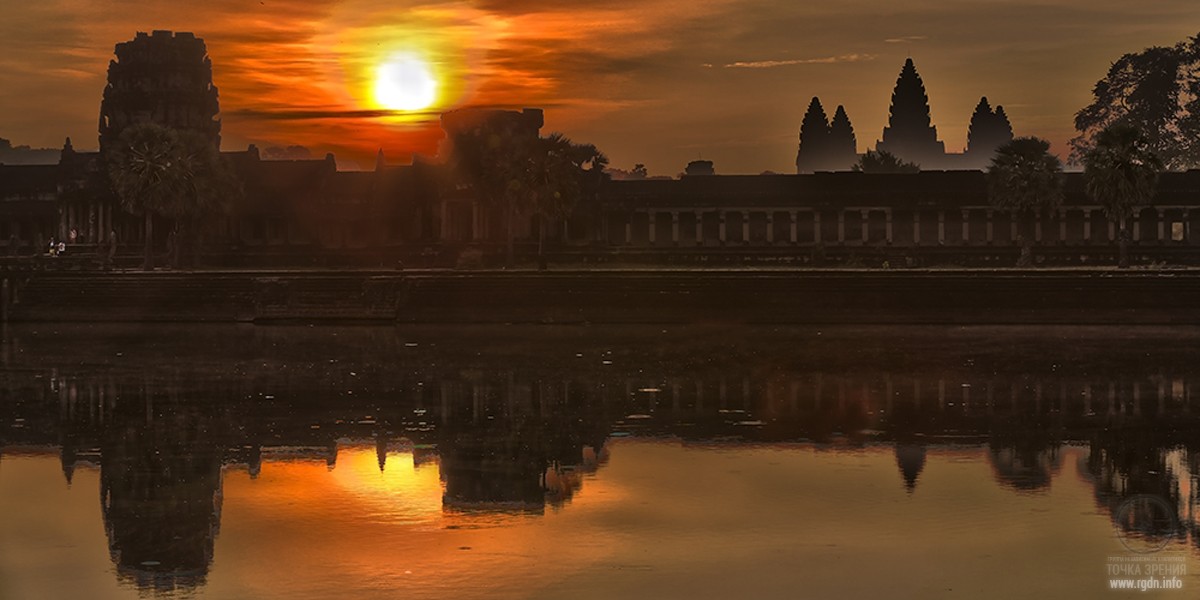
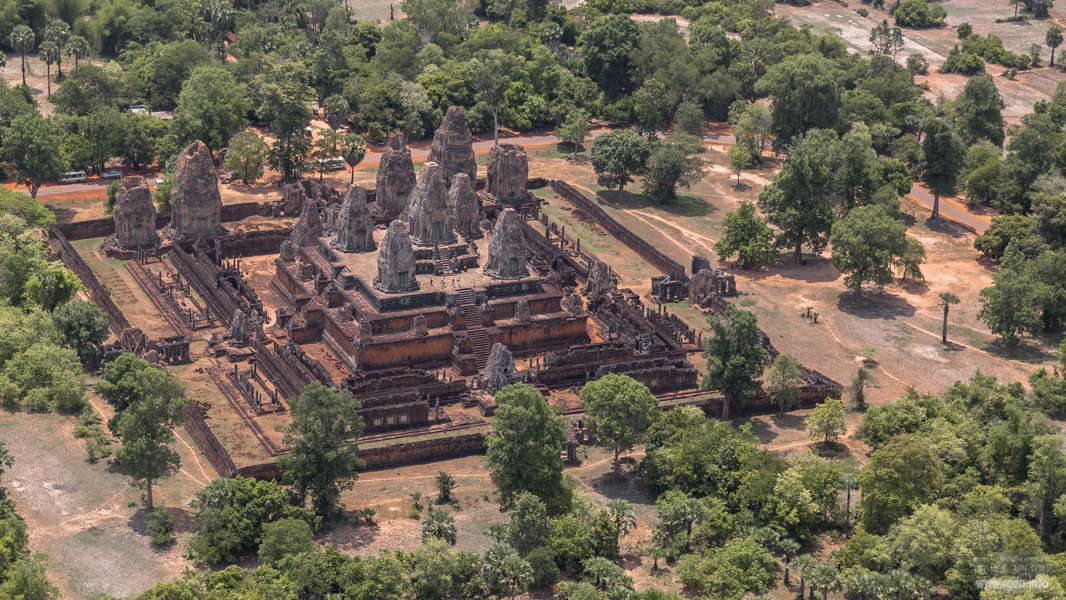
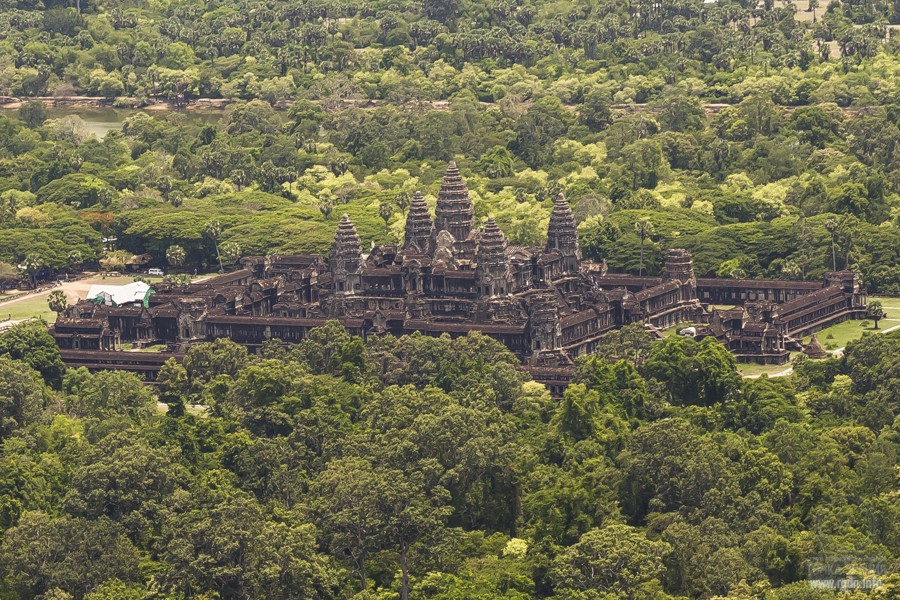
The temple represents a three-level pyramid oriented to the west. Despite quite a complex structure, it was built from the centre to the periphery. No matter which side you look at it from, only three of its five towers are visible, and this is an architectural miracle still nowadays. According to Khmer beliefs, three levels of the temple symbolize the three elements: air, earth and water.
Architecturally, the Temple is a combination of the Hindu temple mountain and the later plan of concentric galleries. It’s a representation of the mythical Mount Meru – the residence of deities, which is mentioned in the famous Sensei of Shambala (Book IV) and also called the World Mountain:
“...the World Mountain is located in the centre of worlds of the material Universe. And it is a place of visit of wise beings like our enlightened people, or demigods as they were called by ancient people, i.e. those who achieved a high spiritual level. Therefore, in ancient legends this mountain was associated with attainment of the genuine human happiness and immortality...”“In the mythology of Ancient India there were a range of myths connected with Meru. According to these ancient views, Brahma, Vishnu, Shiva and other great gods reside on the World Mountain located in the centre of the Universe, with stars, planets and many suns turning around it. There are also records about thirty-three gods who communicate there with each other. Their activities are mentioned as well. For example, on this mountain Vishnu gives advices to other gods how to extract the drink of immortality Amrita.”
“Amrita… sounds very nice,” said Tatiana. “Is it connected somehow with a female name?”
“No. This word originates from ‘amrta’ meaning ‘immortal’. It is akin to a later ancient Greek myth about the Ambrosia drink which supports immortality and eternal youth of Olympic gods. Amrita or Ambrosia is the same as the juice of Soma in the Vedas. In Rigveda it is described as a juice of gods that causes an ecstatic state, grants immortality and extraordinary force. In ancient Indian religious practice the very process of preparation of this juice represented a special ritual. In Avesta this juice is called Haoma. Its cult dates back to the ancient Iranian period. It was also worshipped by Sarmatians and Scythians. Moreover, this juice was called ‘death averting’. It not only changed one’s perception of space and time, but also granted an enormous power, enlightenment and knowledge. And, as ancient Iranians believed, it prepared the way for the soul in the best way. At that, in general this juice of immortality was always called the ‘juice of lotus’. In nearly all legends this sacred juice was described as the juice of an unusual heavenly plant connected with the earth, beautifully and rightly created, which had white-and-yellow and even light golden colour.”
Based on the acquired knowledge and logical comparison of relevant information we can assume Angkor Wat did not serve as a place for believer gatherings or divine services, but was “the abode of Gods”. Furthermore, it was the burial place for kings.
The temple represents a rectangular building of 1500*1300 m. Round the temple there is a 190-m-wide moat. The complex consists of an external yard with three concentric structures (the temple itself) built inside it. The entrance is on the western side. On the entrance side, a long road is laid between the tower and the temple. On the right and left sides of the road there are sculptures of serpents with seven heads (!), resembling guards. Doesn’t this remind of the Chinvat Bridge that we are already familiar with?
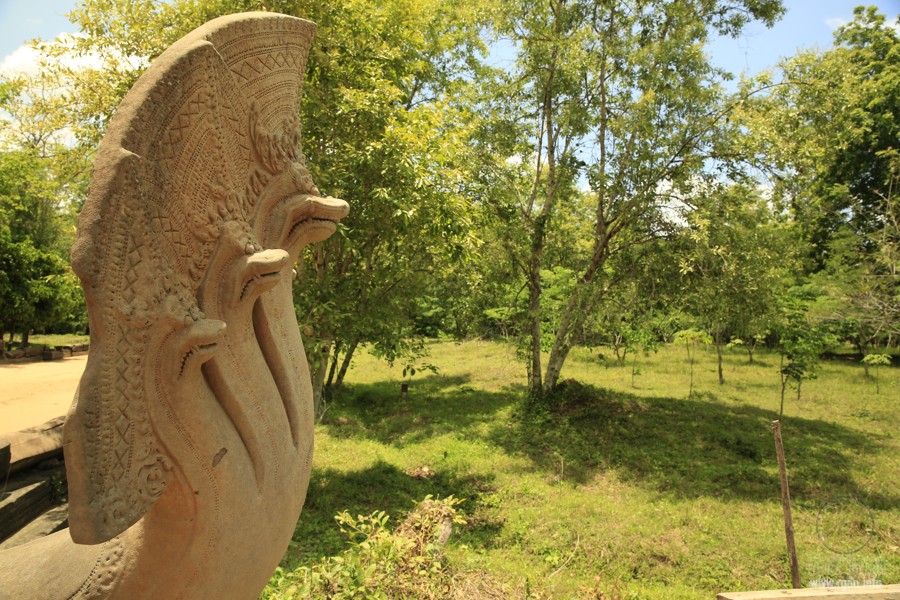
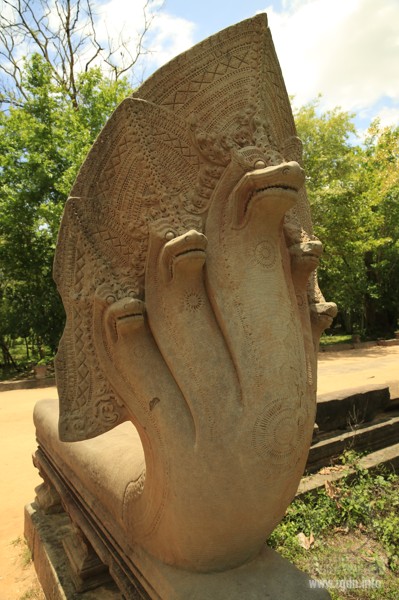
The temple architecture matches its sculptural decoration which plays an important role here. Bas-reliefs with mythological scenes are made on all three levels of the temple.
Three towers are located before the entrance to the first level having dimensions of 215 x 187 m. Here, there are numerous frescoes and friezes depicting Hindu myths. All in all, there are eight giant bas-relief friezes in the first level gallery, the height of which is 2 m and the total length is about 1,000 m. Scenes on the bas-relief friezes depict major episodes of popular Hindu eposes Ramayana and Mahabharata. On the internal side of the gallery, there is a blank wall on which the bas-reliefs are in particular, whereas on the external side there is a double row of columns that form a rather narrow passageway to observe the bas-reliefs. The ceiling is decorated with fretwork reminding of the lotus flower.
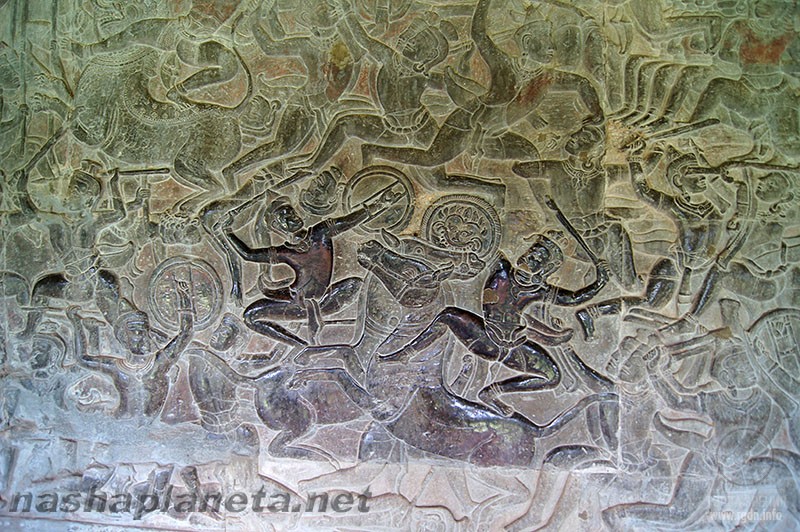

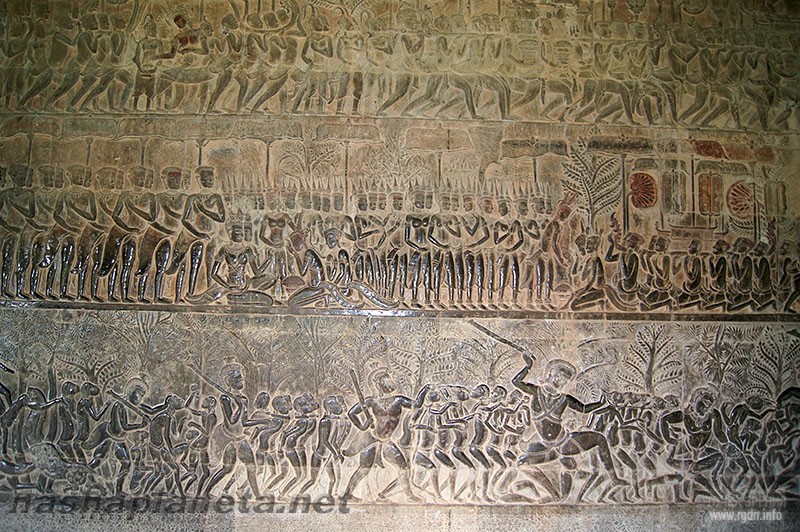
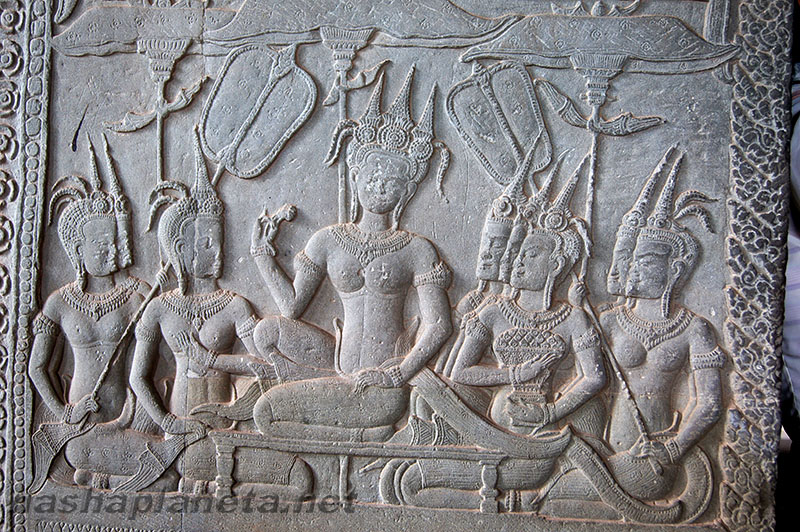
Eight huge stone bas-relief friezes on the first level depict such celebrated scenes as the Churning of the Ocean of Milk, the Battle of Kurukshetra, etc., while their total area makes up 1,200 m².
The second level of the temple has dimensions of 100 x 115 metres. One can get there, walking from the first level through the central entrance along sheltered corridors (from the west to the east). The three over-gate towers of the central entrance are connected with the three towers of the second level by peculiar corridors. The formed inner space is divided into four rectangular courtyards that were turning into artificial pools during the rainy season. On the second level, on the right and on the left there are library buildings, each having four entrances, and the central stairway leading to the temple third level. Ten entrances are located here, each decorated with an improvised roof. Galleries of the second level are represented by corridors. One part of the wall (on the external side) is blind, while the other part (on the inner side) has windows with short figured columns serving as window grates. The corridors open to the internal part of the yard with a double row of pillars making up covered galleries of about 3 m width. Gallery bas-reliefs depict some two thousand Apsaras, none of which is similar to the others.
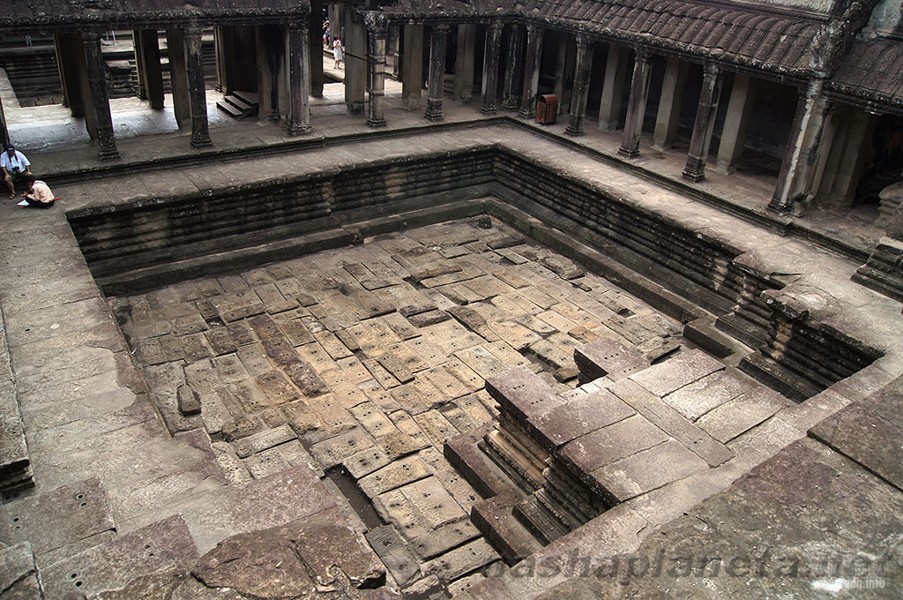
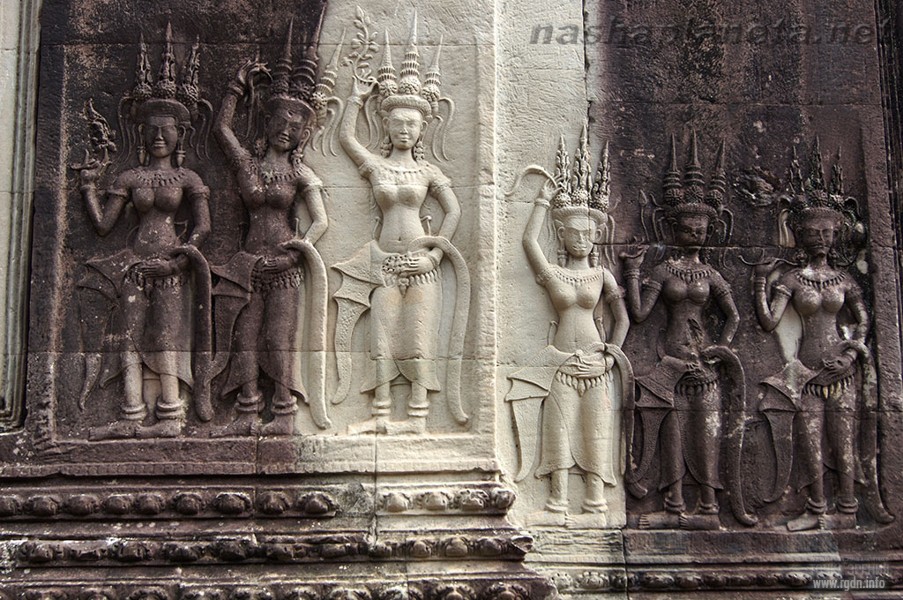
Walls of the second level are decorated with about 2,000 figures of heavenly virgins – Apsaras.
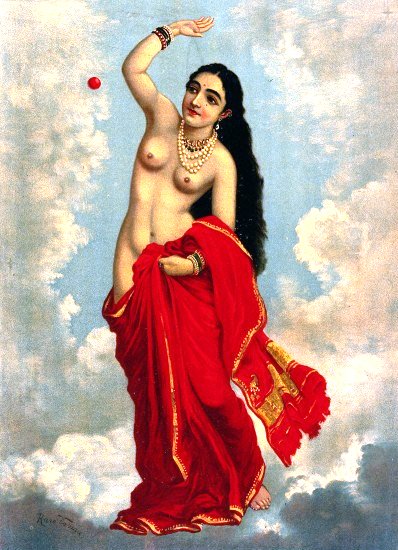
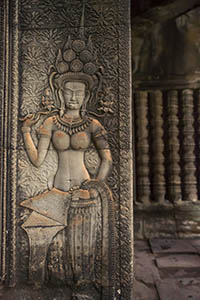
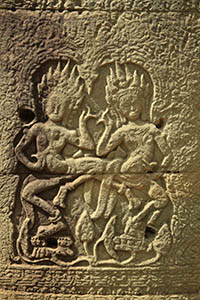
The third level has dimensions of 75 x 75 m and is located 25 m above the ground, whereas the total height of the central tower is 65 m from the ground. The third level space is split into four squares representing courtyards, from where one can ascend both to the corner towers and main towers. 12 stairways with very big stairs lead to the towers. The towers are connected with each other by roomy corridors. From the central tower four galleries open on both sides branch, each one 15 m long. On one side (inwards) a double row of pillars is located, on the other side (outwards) there are windows with grates made of figured columns. Bas-reliefs here are decorated with fretwork depicting demigods (Devatas). The central tower looks particularly regally, if you look at it either early in the morning from the foot of the northeast tower, or at sunset from the foot of the northwest tower. A marvellous view of the vicinity opens up from the third level height.
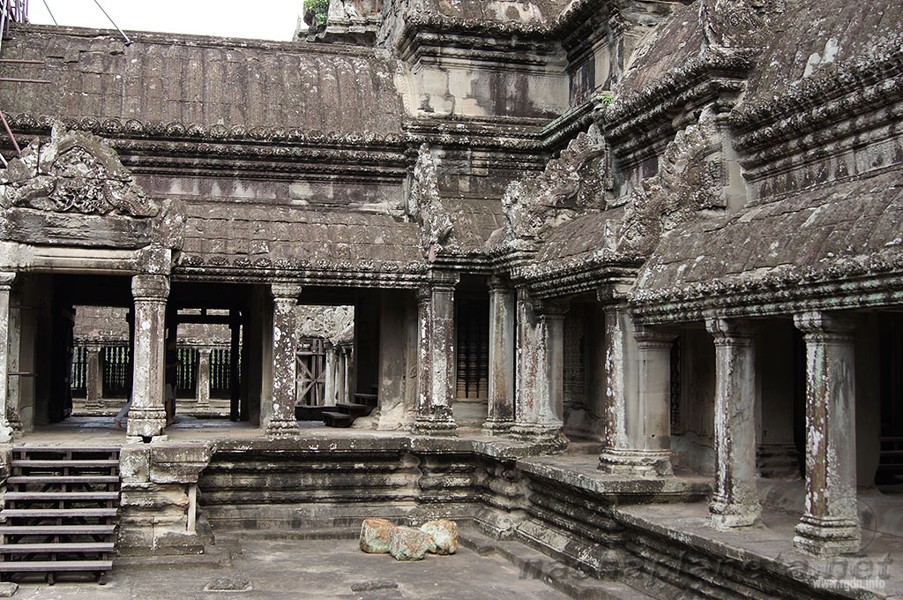
The temple outer wall has dimensions of 1024 x 802 metres and the height of 4.5 metres, being surrounded with a 190-metre-wide moat.
To the east of the temple there is an embankment. From the west one can get to the temple along a levee made of sandstone. The western gate is the main temple entrance, where in the past there was a wooden bridge instead of the levee. For each cardinal direction there is an over-gate tower serving as an entrance to the temple complex. Correspondingly, the western entrance (horupa) is the largest one and consists of three towers now ruined. Maurice Glaize who was Angkor Wat conservator in 1937-1945 mentions this horupa simultaneously hides the complex from the one who enters it and resembles the entire complex. A Vishnu statue known as Ta Reach is located under the southern tower. Possibly, it was initially situated in the central part of the temple. The towers are connected by galleries that have a solid wall on the inner side and square pillars on the outer side. The galleries are spacious enough for elephants to walk along them, while horupa entrances are often called “the elephant gates”. The ceiling between the pillars is decorated with lotus-shaped rosettes, the wall western façade is decorated with dancing figures, and the eastern façade with balustrade windows, figures of men dancing on backs of galloping animals, and Devatas. The outer wall envelopes the area of 820 thousand square metres (203 acres), which was initially occupied by not only the temple, but also city buildings and the royal palace to the north. Just like all other mundane buildings of Angkor, these buildings were constructed of short-lived materials (as distinct from the temple stone structures), and so almost nothing remained of them, except contours of several streets. A major part of the area around the temple is now covered with forests. The western horupa and the temple are connected by a 350-metre-long stone road (platform) with a balustrade of Nagi figures.
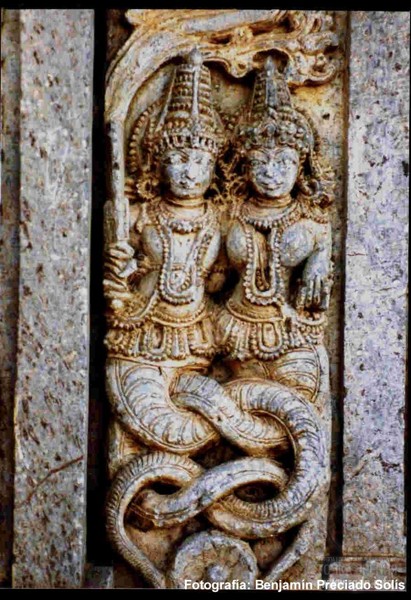
The road has six descents to the city on each side. On both sides of the road there are so-called “libraries” located opposite the third stairway (if we count from the temple). Ponds are between the libraries and the temple. The ponds are not original elements of the temple complex; they were added later, just like the cruciform terrace “guarded” by lion figures and connecting the stone road with the temple centre.
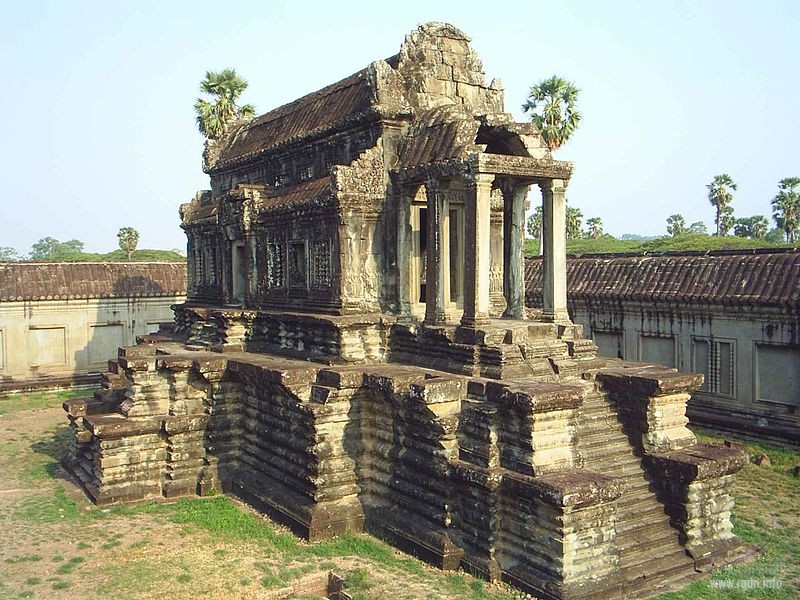
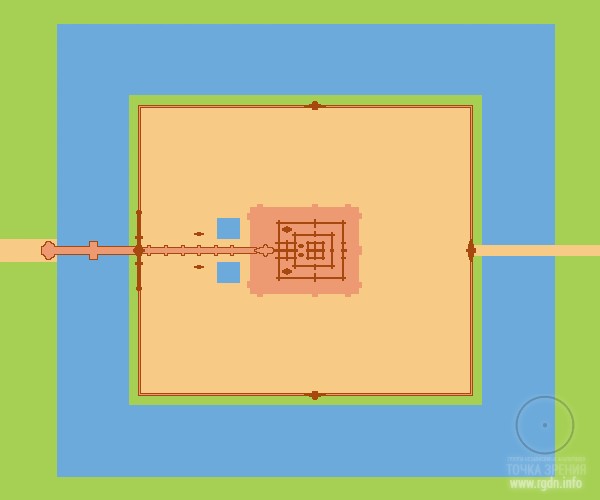
(Angkor Wat layout)
Finally, let’s touch upon the sacral number 72, for there are too many "accidental" coincidences. In view of the Primordial Knowledge brought by Rigden Djappo to the world and given in the AllatRa book, it finally becomes clear what it’s all about.

... The ancient Egyptian vision of the sacral number 72 also relates to the level of perception of Bodhisattva as the Spiritual Being who is directly connected with the world of God, knows the essence, and is capable of managing and using the integrity of the 72 dimensions...
There are 72 dimensions within the ezoosmic grid. Everything that contemporary science calls “the material Universe” exists within the first 6 dimensions only, while the other 66 dimensions are as a matter of fact controlling superstructures that hold “the material world” within certain restrictive limits – the six dimensions. According to the ancient knowledge, 66 dimensions (from the 7th through the 72nd) also relate to the material world, but are not material in their essence...
Attentively examining the images herein, it’s impossible not to notice the number 7 as well. Allusions to the seven dimensions are available not just in Angkor Wat temple buildings, but also in the state symbols of Cambodia.
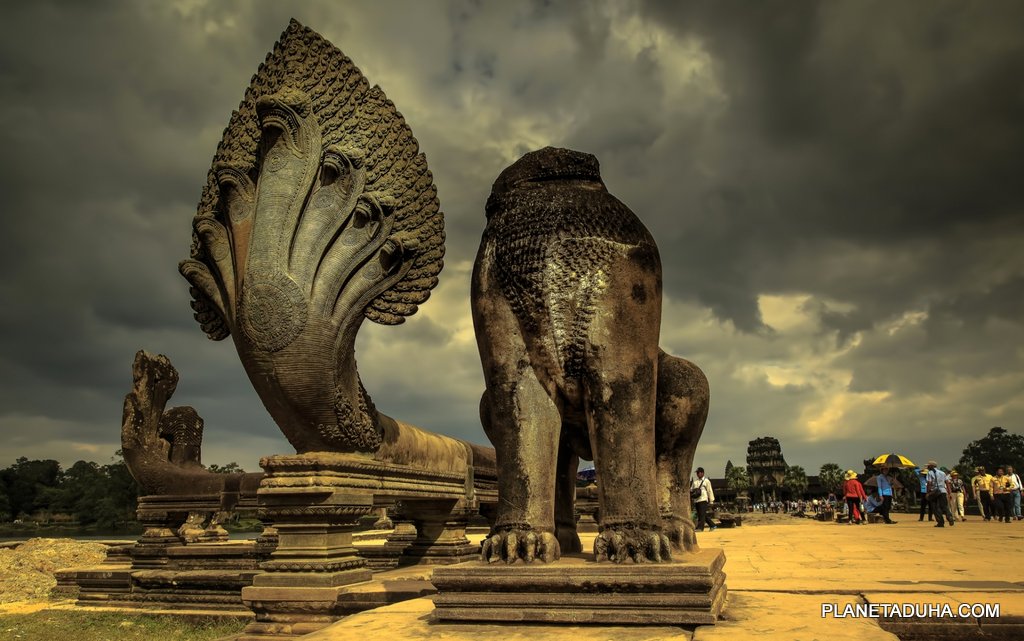
The seven-headed serpent "guarding" the Chinvat Bridge: the beginning of the road leading to main temple buildings
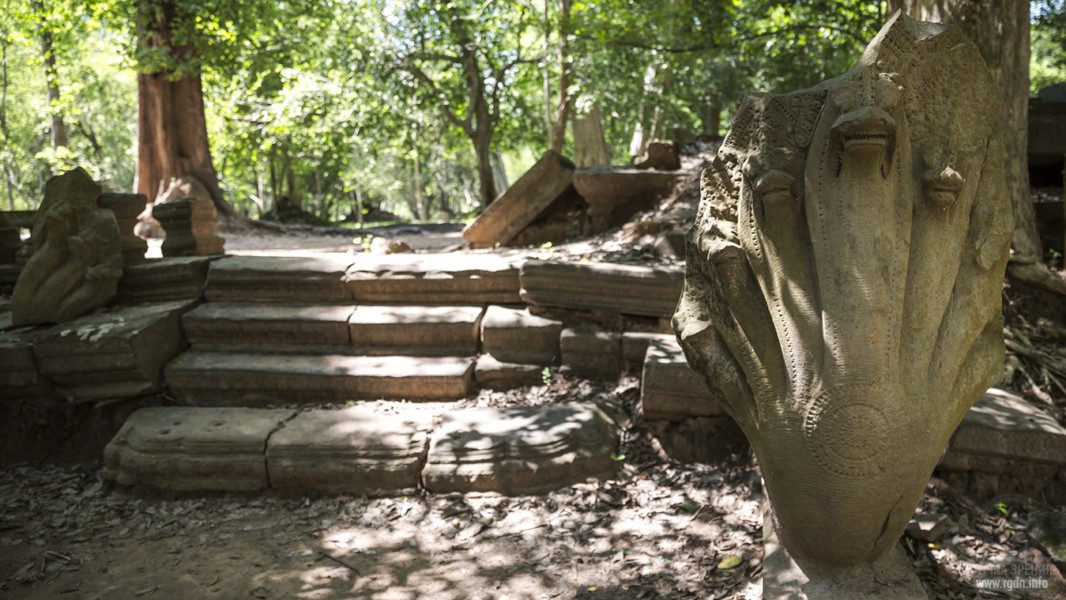
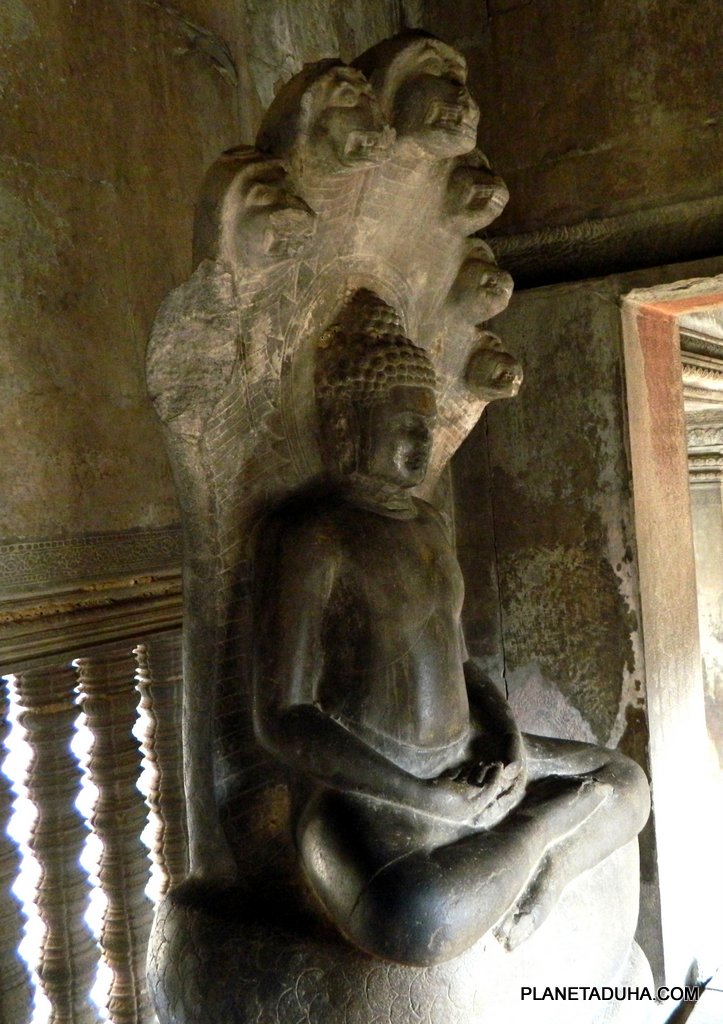
The stone statue of meditating Buddha with the open “hood” of the seven-headed serpent (Guard) above him
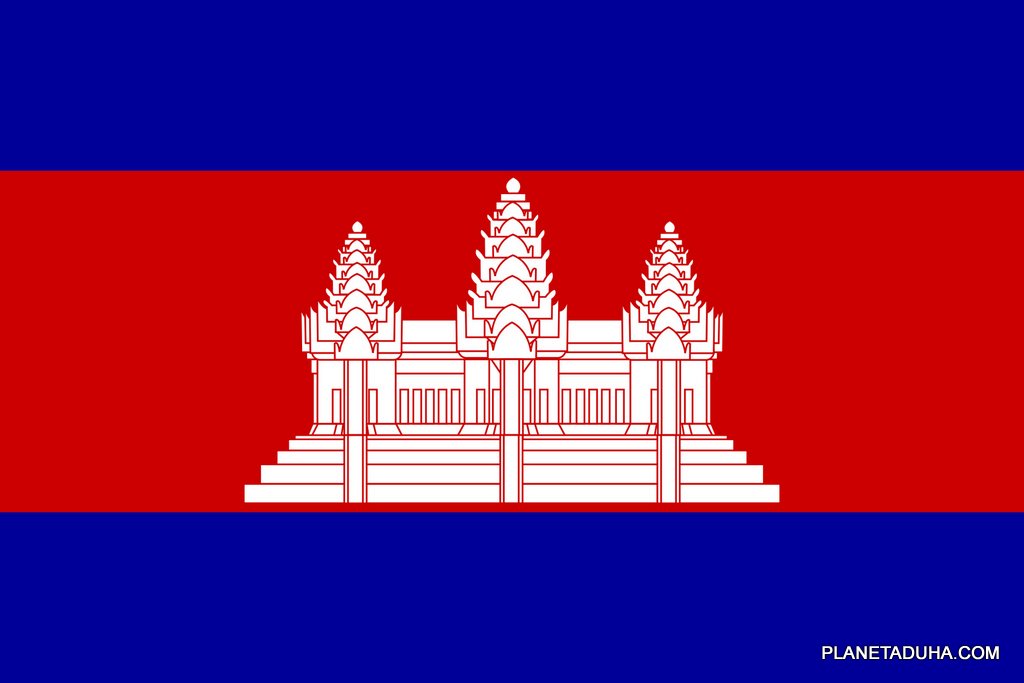
The central part of the Angkor Wat temple complex is the main symbol on the Cambodian state flag. At the ancient building contour we see three towers, each of which consists of seven “cupolas”.
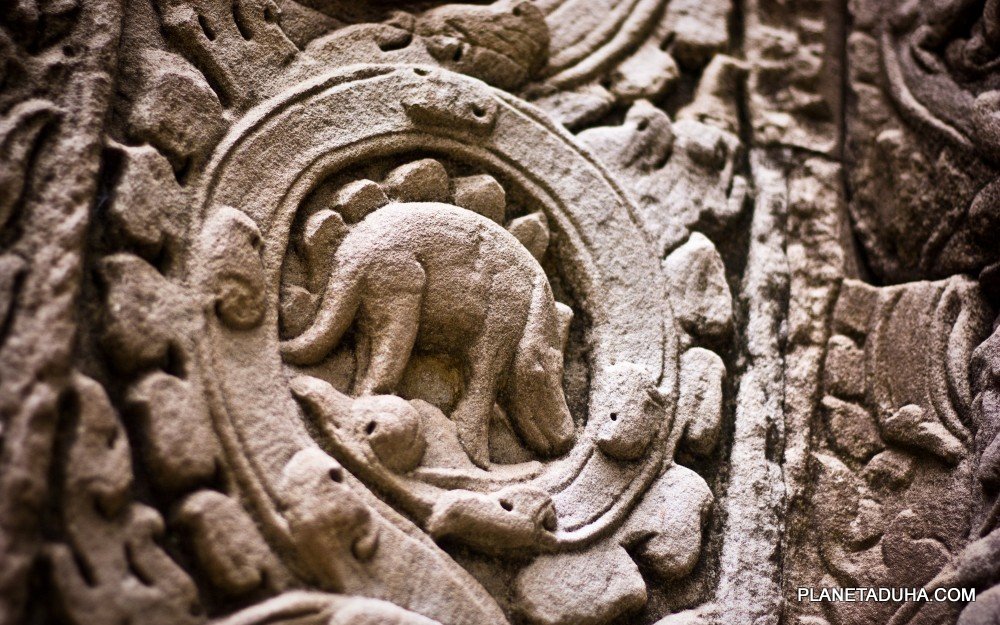
On one of stone frescoes we’ve discovered a figure of a dinosaur-like animal with six “combs”. It may be interpreted as embodiment of the Animal Mind, material system or septon field possessing power over six dimensions only.
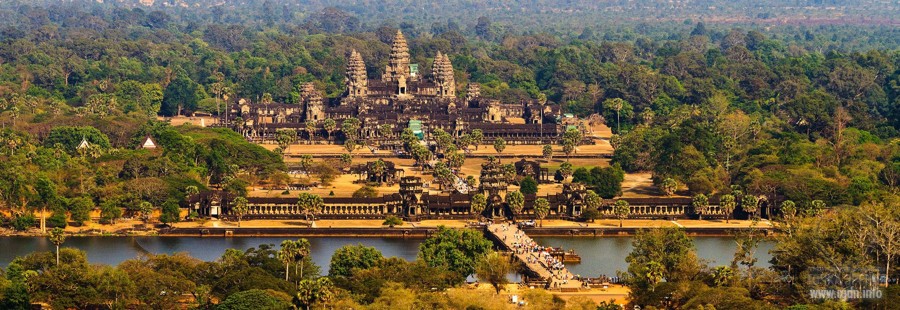
Any person who has familiarized himself or herself with the Primordial Knowledge starts seeing certain common patterns preserved in ancient buildings, whether it’s symbolic script or sacral geometry, and this evidences that our ancient forefathers possessed the original spiritual knowledge of the universe structure and human nature. Angkor Wat is a typical example of that. Certainly, in this article we have touched upon the iceberg tip only, since for more detailed analysis it would be necessary to visit Cambodia and enter the mysterious world of Angkor on our own feet...
However, in one of our nearest articles we shall go back to this marvellous ancient sacred place in order to publish a series of unique photographs of frescoes, bas-relief friezes and sacred architecture. The images were made by a professional photographer who visited Angkor not so long ago and kindly agreed to provide us with such material. Stay with us and follow our publications.
Prepared by Maxim Perepelitsa & Dato Gomarteli
 Angkor Wat. Architecture, frescoes and sacral numbers 7 and 72
votes:
213
Angkor Wat. Architecture, frescoes and sacral numbers 7 and 72
votes:
213
|

Project Aim










Leave comment